Saskatchewan Firsts
Every trip to the Land of the Living Skies is special, but then there are occasions when an unbelievable experience makes a lifelong impression
Every trip to the Land of the Living Skies is special, but then there are occasions when an unbelievable experience makes a lifelong impression
.jpg)
Visiting Saskatchewan, aptly nicknamed the Land of the Living Skies, should be on every waterfowlers bucket list. Decoying large flocks of ducks and geese in the provinces expansive grain fields is guaranteed to make lasting memories. That is probably why the closure of the Canadian border due to the pandemic has made the early stages of the 2020 waterfowl season difficult for so many. The good news is that the magic moments of past seasons can be rekindled, and many hunters are already making plans for next years adventures.
A late-September trip to Goose Haven Outfitters with Kent Cartridge and Stoeger Industries in 2019 will forever be remembered as one of the best trips Ive ever had. Much to my surprise, the fishing proved to be just as memorable as the waterfowl hunting.
Safari River Lakeside Lodge sits on Green Lake, a 16-mile-long, 3/4-mile-wide natural lake in central Saskatchewan. Located 180 miles north of Saskatoon, on the northern fringes of the parklands, this region marks the beginning of the transition zone between the Prairie Pothole Region and the Boreal Forest. Its on this unique landscape that migrating ducks and geese find the first agricultural fields on their journey south. Barley, peas, and wheat are swathed in the fall and left to dry, creating a smorgasbord of grains for staging puddle ducks and geese. That is also why the region makes an ideal location for testing waterfowl guns, ammo, and other products.
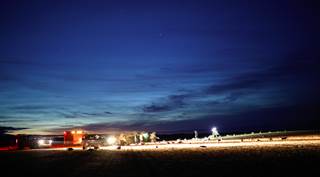
Hunters set duck and goose decoys in a harvested wheat field before dawn. Photo Joseph Edwards
Our goal is to provide unique experiences, and this part of Saskatchewan is set up to do just that, says Lance Robinson, owner of Safari River and Goose Haven Outfitters. Our staff works to offer the ultimate package for outdoorsmen and women, and we feel thats our strong suit.
A Once-in-a-Lifetime Experience
A puff of mallard feathers drifted over the decoys and seesawed to the ground on a light north wind. It was day two, and the field hunting in Saskatchewan had proven, yet again, to be nothing short of spectacular. Flocks of mallards and pintails ranging from 15 to 300 birds poured into the decoysfeet down, wings backin a breathtaking display. Our goal was to test the new Kent Fasteel 2.0 and the new Stoeger M3500, and the results were clear, strapped up in the form of eight-bird limits taken in less than an hour.

Saskatchewan was the perfect place to field test Kent's new Fasteel 2.0 ammo.
Photo Joseph Edwards
Joseph Edwards, a photographer and videographer widely known on Instagram as @hipsterwoodsman, was set up in a layout blind 30 yards behind us capturing awe-inspiring visuals of the decoying ducks. He had yet to fire a shot.
Hipster, get up here and hop in a blind, yelled Jeff Barry, marketing director for Kent Cartridge Company. He handed Edwards two boxes of Fasteel 2.0 as he crawled into a layout blind. Although wed just experienced a miraculous shoot, the group knew this was going to be fun to watch.
My layout blind was positioned to Edwardss left. I leaned over and told him, This is an unreal opportunity. You have ducks pouring into the decoys, an eight-bird limit, and youll be the only shooter. This is a once-in-a-lifetime deal, man.
Thanks for reminding me. No pressure, right? Edwards replied in his thick Georgia drawl. The chamber on the Stoeger M3500 slammed shut with a clang and the show began.
Clouds of ducks streamed over the horizon, beelining for our cut wheat field.
With ducks beginning to jockey for position overhead, I leaned toward Edwards. The good thing is, with you being the only shooter, you get to call your own shots, I said. So, I guess its whenever youre ready.
The first flock was 30 mallards strong and swept across the edge of the decoy spread, hooked into the light wind, and dove 15 yards in front of the blinds. Edwards pushed through the blind doors, and boom, boom. Two shots, two birds down.
Edwards repeated this process three more times, as flocks of mallards and pintailsas many as 75 at a timedecoyed mere yards from the blinds. Eight ducks in nine shots. The group cheered as he crumpled his final bird over the decoys. His smile was ear-to-ear as he hopped from the layout.
With everybody watching, it was a little nerve-racking. Even more so when you dont really know everyone that well, Edwards joked. I was worried the ducks wouldnt come backyou know how birds are, and they had been coming in all morning. These birds up here are much different from what Im used to back home. Ive never seen anything like it.
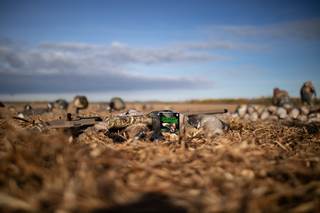
Stoeger's M3500 autoloader cycled flawlessly during our high-volume field shoots for ducks and geese.
Photo Joseph Edwards
I likened the situation and pressure to a golfer having to step up on the tee box in front of hundreds of onlookers. If that were the case, Edwards smashed a Brooks Koepkaesque, jaw-dropping bomb onto the fairway.
This was one of those moments Ill never forget for the rest of my life; it was unbelievable, Edwards said. With this being my first visit to Saskatchewan, it will be hard to match, thats for sure. I feel fortunate to be able to even experience Saskatchewan, let alone this special moment.
Robinson is proud to deliver these experiences to his clients, and he gives a lot of the credit to the area.
When I first came up here, I didnt realize what we had, Robinson admitted. We may not have the most birds, but with these being the first agricultural fields that ducks and geese see coming out of the north, we always have fresh birds. What Joseph was able to do was special, and we take pride in making that happen.
All the hunters shared the typical cheers, jeers, and nice shooting comments as we shuffled around the decoy spread, but I clawed back my parka sleeve to check my watch. Damn, that was quick. Can a waterfowl hunt be too good? The sun hadnt cleared the tree line and we were almost done picking up decoys. Now what do we do?
As the group shared stories, relishing in the clouds of mallards we had witnessed, I sat at the table pushing eggs and hash browns around my plate. I couldnt keep my eyes off the lake. The water was like molten glass, slowly pulsing to the light and varying winds. But Robinsons next comment snapped me back to reality.
So, does anyone want to fish this afternoon? Theres really good walleye fishing, and some guys have been catching northerns, he said. Weve got boats, tackle, and bait, and its all ready to go if anyone wants to try it out.
Before he finished his sentence, I spoke up. Im in! Rather than spend the day napping and just lounging around the lodge, Ill take any opportunity presented to get back outside. This was ideal.
Knowing there might be fishing opportunities, I had packed two medium-action telescoping rods, two spinning reels with braid (left from my last Louisiana redfish trip), and a small Plano tackle box with some essentials. Never having actually fished for walleye or northern pike, I had brought spoons, crankbaits, and a bunch of stuff that was about as useful as a handful of peat moss. Nevertheless, I was rigged up and ready to roll.
Robinson called two local farmers to stop by and give us a quick rundown on the fishing, familiarize us with the boats, and take us out that first afternoon. Good thing too, because I teamed up with Edwards, whose north Georgia roots provided the same amount of walleye and northern pike knowledge I had: zero.
Over the hum of the motor, Shane Dull, our guide for the day, was surprised that neither of us had ever chased walleye before or caught a northern. I explained that I wanted to catch one of those gnarly, toothy, 35- to 40-inch beast-like northern pike advertised on the Saskatchewan Tourism website.
Oh, the big jacks [northern pike] are at the other end of the lake, Dull said, deflating my spirits. We did pretty good here for walleye a couple of days ago though.
The locals dont prefer northern pike, which is understandable considering there is an abundance of tasty walleye in these waters. We were at the mercy of our guide as we began bottom-bouncing with nightcrawlers. It was a combination of trolling and jigging, and it didnt take long for our guide to put us on the fish.
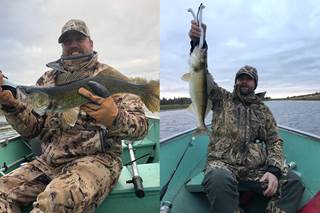
(Left) Joseph Edwards and the author (right) pose with Green Lake walleyes.
Fish on! Edwards yelled as his rod tip bent toward the depths. Again, another first to be checked off Edwardss life list. We kept a few, and threw a handful back, but no sign of a northern pike.
The tug of the Mercury 25-horsepower was enough to bounce a nightcrawler-tipped, bottom-hopper rig along at roughly two miles per hour. After an hour of this, and a few 20-plus-inch, fluorescent-green walleye flopping around at my feet, we were hitting our stride as walleye anglers. I could sense the difference between the heavy, lead jig head bouncing off the rocks 20 feet below and a hungry walleye. Then, boom! The next bite was different. Rather than a bump, it was a tug, and the fish was going in the opposite direction in a hurry.
Ive got a big one! I yelled. Our partners in the other boat 50 yards away mustve thought we were on fire from all the hoots and hollers. My drag sang a tune Im all too familiar with hearing in the marshes of Louisiana when targeting bull redfish. My grip tightened around the rod handle and the fight was on.
Shane, the only calm character in the boat, backed down the motor and eased it into neutral. Knowing we had no experience fishing in northern waters, he probably assumed I had a decent fish, but nothing to get excited about.
The turbid waters of Green Lake swirled as we began to get flashes of what could be attached to my line. It came up fast, giving us all a glimpseit was a massive northern pike. Immediately it headed back to the bottom, peeling line off the reel as the drag whined. After 15 minutes of back and forth, our guide hauled the fish over the side and into the boat.
Even this seasoned Saskatchewan fisherman commented, Oooh, that is a nice one, which meant a lot, knowing he has probably seen his fair share of true giants come out of these waters.
This was my magic moment. Decked out in duck hunting gear, walleye flopping in the boat, I hefted the monster up for a photo. Much like Edwards when he stepped from his layout blind, I smiled ear-to-ear as he snapped photos of me and my pike.

(Left)The author poses with his sought-after northern pike. (Right) Local guide Shane Dull holds up the author's northern pike before release.
We spent the following afternoons on our own, trolling crankbaits and Rat-L-Traps for walleyes and jacks (now experienced northern pike fishermen, they quickly became jacks).
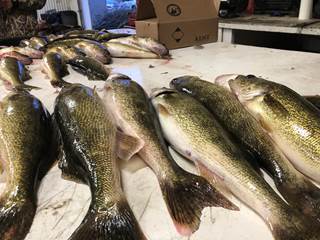
This is what its all about, Robinson said. We have the lakefront resource, theres grouse, and we want people to leave here having experienced the ultimate adventure rather than just duck and goose hunting in the morning and lounging all afternoon. Investing in a trip like this can be a once-in-a-lifetime experience, and we want our guests to feel like they got everything out of every minute they were with us.
For me, three afternoons boating walleye and northern pike put a bug in me to return to Saskatchewan for more than just ducks. Unfortunately, the two medium-action, telescoping rods I brought on that trip will not be making anotherboth were broken by gnarly, toothy jacks who decided they would not be caught by a couple of amateurs. Exactly as Id hoped.
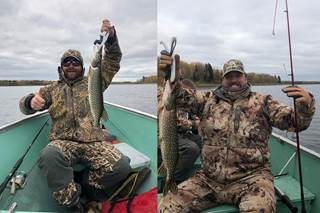
(Left) The author poses with another northern pike. (Right) Joseph Edwards shows the northern that broke their final medium-action spinning rod.
If you find yourself with unguided fishing opportunities in Canada, dont be intimidated by a lack of experience. Try the following techniques to land great-eating walleye and aggressive northern pike.
Jigging: Using a live minnow, plastic curly- or paddle-tailed grub, or nightcrawler on a jighead, you can simply drop the weighted bait to the bottom and vertically raise and lower it. Many times, drifting with a light wind will allow you to cover more ground to find fish. Stay near ledges where larger fish are targeting baitfish in shallower water.
Trolling: A deep-diving crankbait, spoon, or lipless crankbait like a Rat-L-Trap trolled at 1 to 2 miles per hour, 20 or more feet behind the boat can quickly draw in hungry walleye and northern pike. Keep in mind, these fish can be aggressive, so dont hesitate to increase boat speed if nothing is biting.
Bottom Bouncers: This is a combination of jigging and trolling, using a rig specifically designed to bump off the rocks below. A bottom bouncer offers the ability to skip a weighted leg of the rig off the bottom while suspending the bait on a crawler harness. Bait bottom bouncers with nightcrawlers and troll slowly along deep ledges.